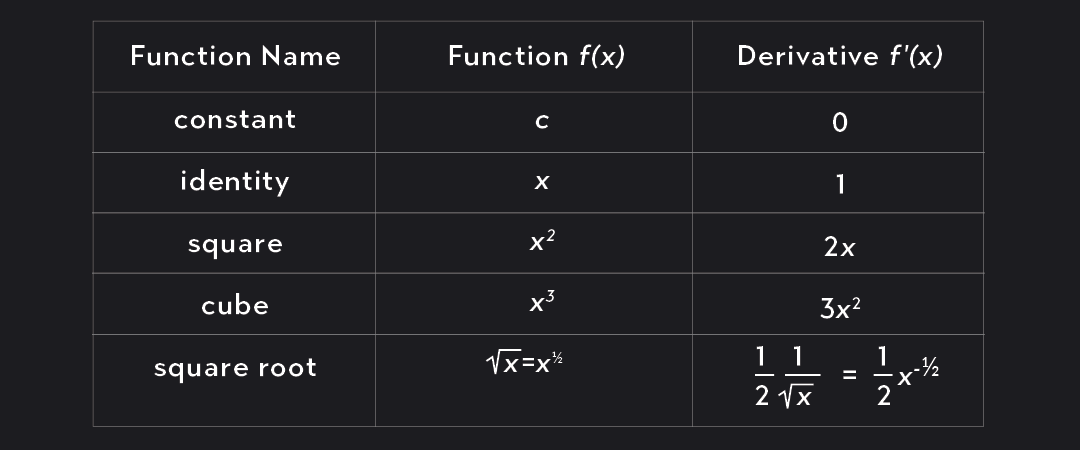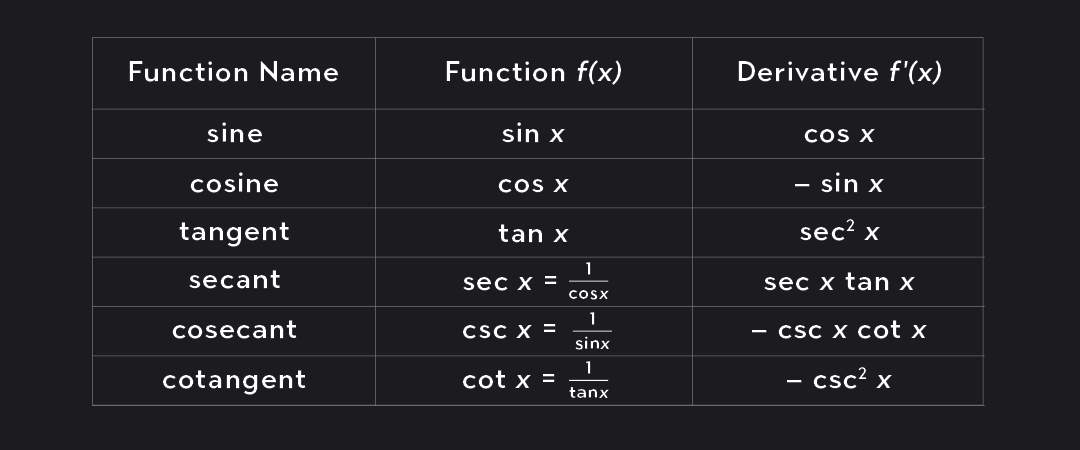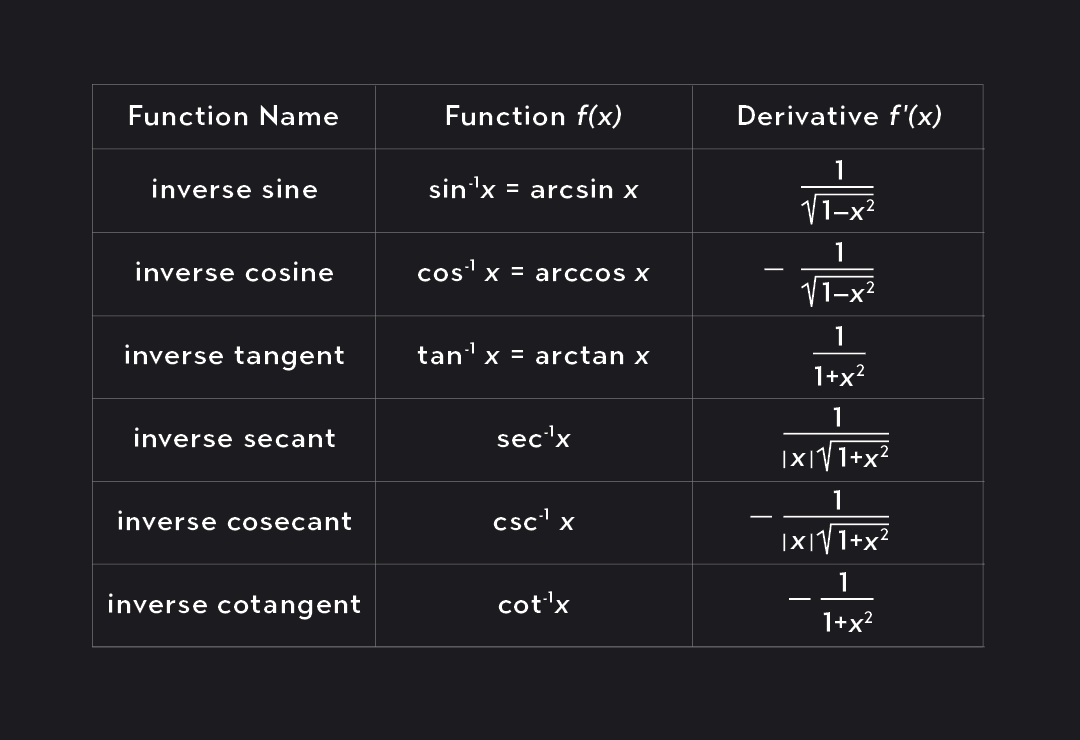How Do Derivative Rules Work?
What is a Derivative?
Derivatives of Common Functions
Derivative Rules
How Do Derivative Rules Work?
The derivative is one of the fundamental operations that we study in calculus. We use derivatives to measure rates of change of functions, which makes them useful in every scientific field, from physics to economics to engineering to astronomy.
Because of their ubiquity and usefulness, the ability to quickly differentiate (that is, to compute the derivative of) a function is a handy skill to have if you’re working in a math-based discipline. However, when you’re first starting out with calculus, derivatives can feel complicated and tedious to compute.
Fortunately, there are a set of derivative rules that you can use to break down any derivative computation into manageable pieces. Once you master these rules, you’ll be able to compute derivatives in mere seconds. This article will walk you through the most common derivatives and derivative rules, and will give you the tools that you need to start improving your differentiation skills.
What is a Derivative?
Before we jump into derivative rules, let’s briefly discuss what a derivative is and why we might want to compute them in the first place.
In short, the derivative of a function tells us about its rate of change. As an example, suppose you’re driving along an interstate highway and the function f(t) measures the distance (in miles) from your starting location as a function of the time t (in hours) since you started driving.
If you were to look at your car’s speedometer two hours into the trip, it would tell you how fast your car was traveling (in miles per hour) at that moment. The derivative of the function f tells us the same information: f′(2) is the instantaneous rate of change of f at t = 2. If we know the derivative f′(2) at every time t, we can compute or estimate a lot of interesting properties of the motion of the car.
In practice, to compute the derivative of f we need some information about the function f. This often comes in the form of a formula, like f(t)=30t23+20ln(t+1). We’ll see shortly that derivative rules give us a way to take a seemingly complicated differentiation task like this one and break it up into smaller and simpler derivatives.
Derivatives of Common Functions
For derivative rules to be useful, we first need to know how to compute derivatives of a handful of base functions. Here are the derivatives of the functions that you’ll frequently run into in calculus and other scientific contexts.
Derivatives of Power Functions
These functions appear frequently in almost every mathematical setting due to their simplicity, and their derivatives are connected by a common rule that we’ll cover in the next section.
Derivatives of Exponential and Logarithmic Functions
The exponential and logarithmic functions play key roles throughout both theoretical and applied mathematics. One of the defining characteristics of the natural exponential function ex is that it is its own derivative.
Derivatives of Trigonometric Functions
Trigonometric functions are useful in any situation that involves periodic behavior, where a function takes on the same values in repeating intervals. Note that the variable x in these functions is implicitly in radians.
Derivatives of Inverse Trigonometric Functions
These are included for completeness, but note that these functions and their derivatives rarely appear outside of calculus itself. It’s useful to know that they exist, but arguably you can get by without memorizing these derivatives.
Derivative Rules
Once you have a grasp of the basic derivatives, the derivative rules provide a means of differentiating more complicated functions by breaking them into pieces. For each rule, we’ve provided a few examples to show how the rules work.
The Power Rule
In the tables above we showed some derivatives of “power functions” like x2 and x3; the Power Rule provides a formula for differentiating any power function:
dxdxk=kxk−1 This works even if k is a negative number or a fraction. It’s common to remember the power rule as a process: to differentiate xk, bring the power k down in front of the expression, then decrease the old exponent by one. Here are a couple examples:
The Sum/Difference Rules
The Sum Rule says that we can differentiate the sum of two functions simply by differentiating the two functions separately and then adding the results together. The same goes for the difference of two functions:
dxd(f(x)+g(x))=dxdf(x)+dxdg(x) dxd(f(x)−g(x))=dxdf(x)−dxdg(x) A quick way to remember this is “the derivative of the sum is the sum of the derivatives.” Here are some examples; note that we can differentiate the individual functions using the power rule or by looking back at the tables in the previous section.
dxd(x2+3)=dxdx2+dxd3=2x+0=2x
dxd(ex−sinx)=dxdex−dxdsinx=ex−cosx
The Constant Multiple Rule
When differentiating, we can “pull” constants outside of the derivative operator:
dxd(cf(x))=cdxdf(x) In other words, to differentiate a function multiplied by a constant, we can differentiate the function first, then multiply the result by the constant. Here’s an example:
By combining the Sum Rule, the Constant Multiple Rule, and the Power Rule, we’re able to compute the derivative of any polynomial function:
dxd(4x4−7x2+3x+10)
=dxd(4x4)−dxd(7x2)+dxd(3x)+dxd10
=4dxdx4−7dxdx2+3dxdx+dxd10
=4(4x3)−7(2x)+3(1)+0
=16x3−14x+3
The Product Rule
Things start to get a little tricky here, because the derivative of the product of two functions is not the product of the derivatives. It’s a little more complicated than that:
dxd(f(x)⋅g(x))=dxdf(x)⋅g(x)+f(x)⋅dxdg(x) The Product Rule says that the derivative of the product of two functions is the derivative of the first function times the second function plus the first times the derivative of the second—try saying that five times fast. It’s a little easier to read and remember the Product Rule if we write the derivatives in a different notation:
(f⋅g)′=f′⋅g+f⋅g′ Here are a couple examples of the Product Rule in action:
=ex⋅sinx+ex⋅cosx=ex(sinx+cosx)
=3x2lnx+x2
The Quotient Rule
Similar to products, differentiating the quotient of two functions is more involved than simplify dividing one derivative by the other:
dxd(g(x)f(x))=(g(x))2dxdf(x)⋅g(x)−f(x)⋅dxdg(x) (gf)′=g2f′⋅g−f⋅g′ The numerator in the formula for the quotient rule looks a lot like the product rule, but note the minus sign. This one is harder to remember, but you can use a mnemonic like this one or even come up with your own. Here are some example applications of the quotient rule:
=(x−1)2(sec2x)(x−1)−(tanx)(1−0)
=(x−1)2(x−1)sec2x−tanx
=x6−3x2=−x43
(Notice that we could have also done that last example with the Power Rule: (x31)′=(x−3)′=−3x−3−1=−3x−4=−x43. In math there are often multiple ways to approach a single problem.)
The Chain Rule
We save the best for last: The Chain Rule is arguably the most important of the derivative rules, as it shows up very frequently and has wide-reaching applications in calculus. The Chain Rule enables us to differentiate compositions of functions, or “functions inside other functions.” There are two ways in which the Chain Rule is typically presented:
f(g(x))′=f′(g(x))⋅g′(x) dxdy=dudy⋅dxdu The first formulation of the Chain Rule above is more explicit, but the second is a little bit easier to remember. They both say the same thing: to differentiate a composition of two functions, we differentiate the “outside” function and plug the “inside” function into it f′(g(x)) and multiply that by the derivative of the inside function g′(x).
When applying the Chain Rule, it’s often helpful to assign names to the outside and inside functions to help you plug them into the formula. Here’s an example of that process:
To compute dxdcos(x2):
Let f(u)=cosu and g(x)=x2, so that f(g(x))=cos(x2).
The derivative of the “outside” function is f′(u)=−sinu, and we plug the “inside” function into that to get f′(g(x))=−sin(x2)
The derivative of the “inside” function is g′(x)=2x
The Chain Rule then says that dxdcos(x2)=f′(g(x))⋅g′(x)=(−sin(x2))(2x)=−2xsin(x2)
Here’s another example using the fractional derivative notation:
To compute dxdesinx:
Break the function into pieces: Let y=eu and let u=sinx
Compute derivatives: dudy=dudeu=eu and dxdu=dxd(sinx)=cosx
The Chain Rule then says that dxdesinx=dxdy=dudy⋅dxdu=eu⋅cosx
We aren’t quite done yet. Our original function was in terms of x, so we need to write the derivative completely in terms of x. Plug u=sinx into the derivative we just computed to complete the process: dxdesinx=eu⋅cosx=esinx⋅cosx
Explore Outlier's Award-Winning For-Credit Courses
Outlier (from the co-founder of MasterClass) has brought together some of the world's best instructors, game designers, and filmmakers to create the future of online college.
Check out these related courses:










